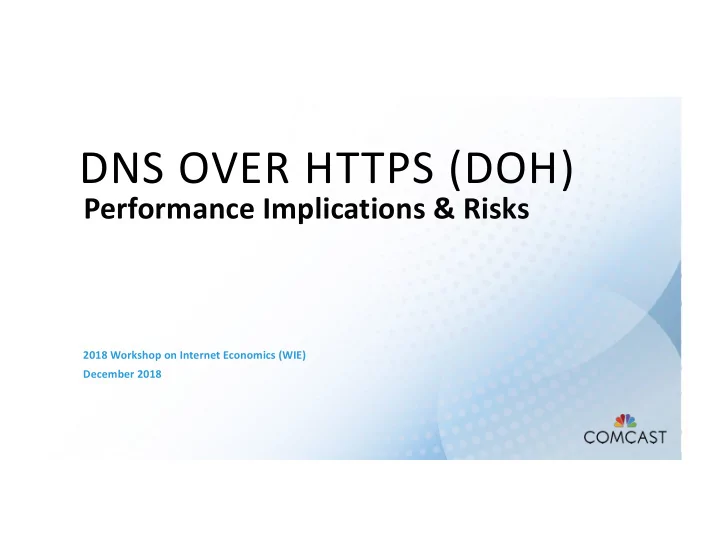

DNS OVER HTTPS (DOH) Performance Implications & Risks 2018 Workshop on Internet Economics (WIE) December 2018
DOH – THE PROTOCOL DEVELOPED TO COUNTER PERCEIVED THREATS • Hostile governments & political environments: • Surveillance by listening on the wire • DNS modification to prevent access to politically-sensitive content • Malware and attacker-based DNS response modification: • Attacker on the wire between stub and resolver • Commercial use of DNS data: • Passive collection, sharing, and monetization of DNS queries by DNS operators (e.g. ISPs, WiFi hotspot operators) • Active DNS modification for NXDOMAIN redirection HOW IT WORKS • Encrypts over-the-wire communications between the stub (client) and recursive server, via TLS • Uses TCP/HTTPS as a protocol rather than UDP/TCP port 53 DNS • Brings in much richer HTTPS-based client capabilities (including fingerprinting/tracking) compared to simpler and more compact UDP/53 DNS protocol SO FAR SO GOOD! 2
DOH – THE IMPLEMENTATION THE STUB IS THE BROWSER OR MOBILE OS • Google Chrome (61%), Apple Safari (15%), Mozilla Firefox (5%) • Android (75%), iOS (22%) “TRUSTED RECURSIVE RESOLVERS” • Each browser / OS appears likely to choose its own default resolver • The client software will turn it on by default (so the transition could happen rapidly is 2 or 3 actors implement) • Google: Google Public DNS (assumed) • Mozilla: Cloudflare (announced) • Apple: Unknown IF JUST GOOGLE AND MOZILLA MOVE • 75% of the world’s mobile devices switch from current DNS to centralized DoH • 2/3 rds of the world’s web browsers switch from current DNS to centralized DoH UH OH… 3
RISKS DRAMATIC CENTRALIZATION OF THE INTERNET’S MOST WIDELY DISTRIBUTED PROTOCOL • A centralized commercial authority decides unilaterally what performance/security tradeoffs to make for users, as opposed to use—driven tools like VPNs • 75% of mobile-based DNS traffic to one US-based commercial provider & 2/3 of browser-based DNS traffic to two US- based commercial providers (61% to just one) • Tantalizing attack target: hit 2 or 3 operators and take down the global DNS via BGP hijack, DDoS, compromise of internal tools/systems, compromise of an admin account from 1 – 2 dozen sys admins • Alluring surveillance target: hit 2 or 3 operators to target for surveillance / collection • Via legal (incl. US NSL) or extra-legal means, including on the wire, in the data center, in the hardware • Data monetization bonanza: just 2 operators have full history data • 2 operators will have full history data on 2/3 of the global Internet where they have little/none today • Reidentification likely to be trivial & trackability moves to the device/individual level, just like other HTTP tracking NO MORE LOCAL POLICY EXPRESSION IN EACH NETWORK CONNECTING TO THE INTERNET • DNS-based parental controls & malware detection (ISP, campus/EDU, enterprise, government), RPZ • Split DNS (i.e. internal-only names), including private corporate names; ISP provisioning and Hot-spot splash screens • Passive DNS security tools 4
MEASUREMENTS TO DATE SEVERELY LACKING • For such a potential large-scale change, significant and dependable measurements are required, including peer review and community consideration of the results and implications. • Measurements to date come from only from Mozilla: • 25,000 self-selected users of the Firefox “nightly build” (users that opt-in to test new features) • These self-selected users may or may not measure enterprise, campus, and ISP breakage risks • No idea if local factors such as WiFi, traffic concurrency, or other issues confounded the measurements • “Most” queries (whatever most means) were said to be 6 ms slower. But this only measures DNS query response time, not the time to fetch the destination content and whether that was fully localized via a CDN – in essence it was slower to get AN answer and unclear if it was the BEST / MOST LOCAL answer. • This placed no significant load on the end resolver, so was not a representative load test. This is a concern as the resolver load on a per-query basis is likely to be much higher for DoH vs. UDP/53 DNS. For comparison, the Comcast DNS resolvers receive over 500 billion queries per day. The infrastructure to handle 25,000 users for a few hours is in no way comparable to billions of queries, so no server-side scaling conclusions can be drawn. 5
MEASUREMENTS NEEDED BEST ANSWER VS. ANY ANSWER, OPEN DATA, BETTER CONTROL OVER VARIABLES • Control the end point so as to avoid the influence of confounding local factors such as WiFi, traffic concurrency – using something like RIPE Atlas or (FCC MBA) SamKnows probes • Distinctly compare a control (ISP DHCP-issued DNS resolvers) vs. 3 rd party public DNS resolvers vs. DoH resolvers • Test query response time (QRTT) for each of these resolvers • Test HTTP content retrieval time for each of these resolvers – ensuring that the queried names include names that are CDN-based and likely to be most localized (most popular content – not long tail) • This has never really been done at scale, even for ISP resolvers vs. 3 rd party public resolvers • Compare all results by network/DNS resolver/DoH resolver and by geography (i.e. state, country, continent, time zone) • Possible some networks and resolvers will be better than others, results may vary geographically • Compare content retrieved (esp. look for failures such as broken geo-fencing, etc.) • Make resulting data publicly available for study • There are many opinions about performance – but little data exist – data can help 6
Recommend
More recommend